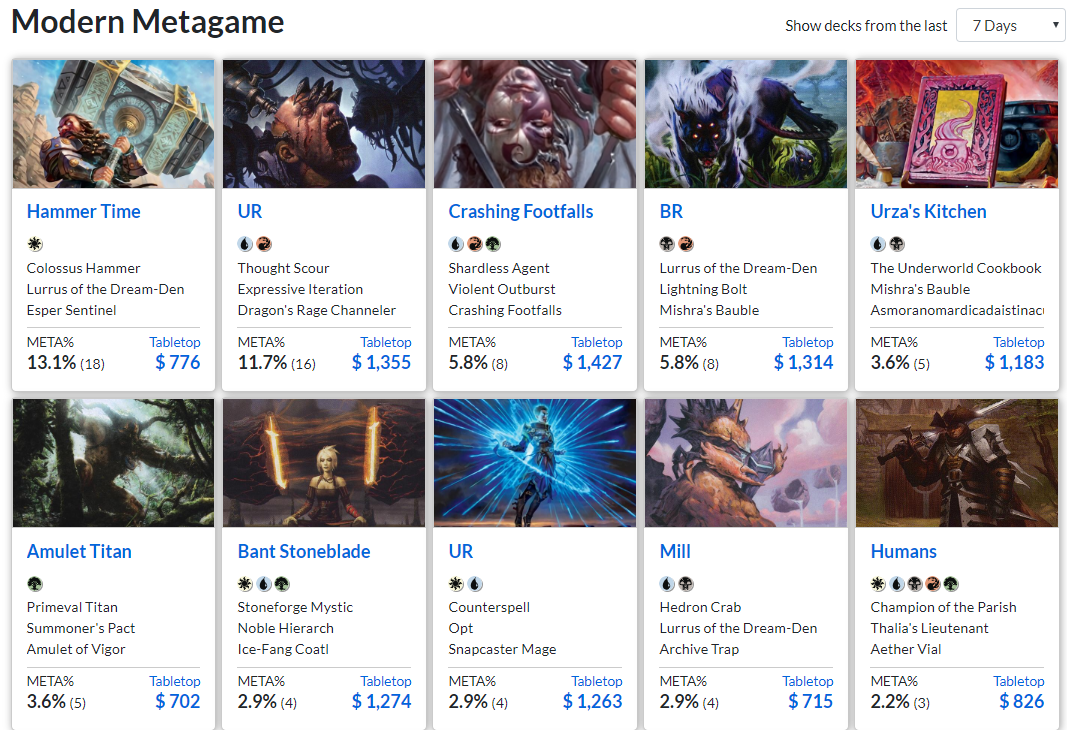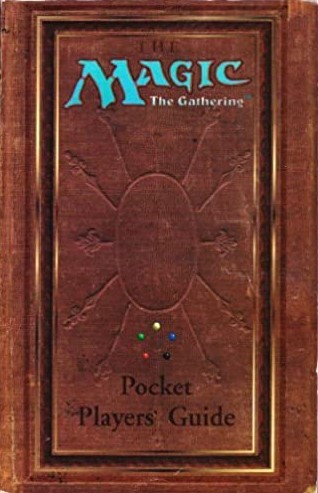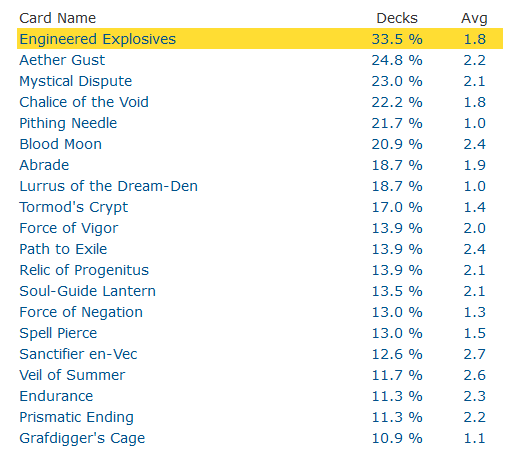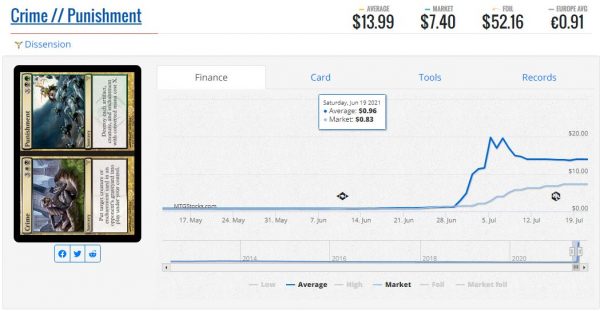Are you a Quiet Speculation member?
If not, now is a perfect time to join up! Our powerful tools, breaking-news analysis, and exclusive Discord channel will make sure you stay up to date and ahead of the curve.
The creator of Magic: the Gathering, Richard Garfield, speaking at the 2000 Game Developers Conference, described a metagame as "How a game interfaces with life." This is a beautiful philosophical definition but is much broader than what players generally think of when they think of metagames. For most Magic players, a metagame refers to the cards, decks, and general strategies that define a given format. The Modern metagame for example is comprised of all the viable decks made from cards legal in the Modern format. Let's explore both the more narrow player-understood meaning of metagame and Garfield's more broad definition. In doing so, we will discover how related they are, especially when we approach the secondary market.
Top-Tier Decks And Strategies
When thinking about metagames, one of the first things players think about is the top decks, the most powerful or most played strategies in a given format. While many decks may be viable in a format like Modern, the top ten decks are the decks you are most likely to encounter in a given event. Here's a sampling of the top ten decks in the Modern format from MTGGoldfish from the last seven days, at the time of this writing:

We choose our deck for a format based on many criteria: format viability, financial constraints, playstyle, and other reasons. You can see more on choosing a deck to play in the article Buying Into Modern. Once we've selected a deck, it is important to understand the deck's strengths & weaknesses against the top decks in the field. This is called metagaming. The act of metagaming is the process of examining the metagame of a given format, and choosing to include cards in your main deck or sideboard which you can use specifically to aid in thwarting the common strategies you expect your opponents to bring to the table. Sometimes this can even determine what deck we choose to play. Assuming we've chosen a deck for some number of the reasons previously discussed, let's look at where metagaming is most relevant: the sideboard.
Sideboards And Silver Bullets
Once you understand your deck and its strengths and weaknesses, the sideboard is the place to have specific cards to fight the strategies of your opponents. The first cards players think about when looking for sideboard options are the so-called "silver bullets," narrow but powerful cards that exist in a given format and can be used specifically to aid in thwarting common strategies you could expect your opponents to bring to the table. Silver bullets have existed in Magic as far back as Limited Edition Alpha, the very first Magic set.
Developing these narrow answers was a conscious decision made during the two years of playtesting done by Garfield and his playtest group. "The original plan was to include cards that thwarted every obvious simple strategy," Garfield wrote in his piece on the creation of Magic in the 1994 Magic: the Gathering Pocket Player's Guide, one of the first major publications written on the strategy of the game. The article was reprinted on the Magic: the Gathering website for the game's 10th anniversary in 2013. The goal over time, Garfield continued was "to add new cards which would defeat the most current ploys and keep the strategic environment dynamic." The power of silver bullets has risen and fallen over the years. In Modern, cards like Surgical Extraction, Relic of Progenitus, and Stony Silence are staples which consistently see play. The first two are answers to graveyard-based strategies, perennially powerful strategies which can otherwise be difficult to interact with, hence the necessity for these powerful answers.

"The original plan was to include cards that thwarted every obvious simple strategy" - Richard Garfield, discussing "silver bullet" cards in Limited Edition Alpha, "The Creation of Magic: the Gathering," Magic: the Gathering Pocket Player's Guide
Flexible Answers
Another class of sideboard cards are what can be dubbed "Flexible Answers." These include cards like Abrade, Spell Pierce, and Engineered Explosives. Because of their flexible nature, these cards are often included in the maindeck in one and two-ofs, as well as in the sideboard for their ability to answer multiple kinds of threats. The most open-ended of these cards, like Engineered Explosives, are often called "catch-alls." While not as powerful as the silver bullets, the increased utility of these cards makes them valuable even when not facing the deck they were included primarily to fight against.
Most Played Modern Sideboard Cards
Based on metagame data from MTGTop8.com, these are the top 20 most played sideboard cards in Modern:

It's not surprising to see a flexible card like Engineered Explosives in the top slot. Aether Gust and Mystical Dispute in the second and third slots also make sense at the top of the list given that Izzet Blitz, and Izzet Tempo are two of the top decks, wanting Mystical Dispute for the pseudo-mirror matches, and Aether Gust against Amulet Titan, the Crashing Footfalls deck, and anything else playing green/red.
As a player, it's a good idea to have some number of these cards in your collection, if not one or two of every card on the list, regardless of what deck you are currently playing. This is especially true of the colorless artifacts on the list. Doing so will allow you to have tools in your collection for whatever direction the metagame may shift, and be ready to include them in your sideboard or deck as necessary.
As a trader or speculator, these are all fine cards to have in your binder. Their steady demand means they will be relatively easy to move if you're ready to unload, and their prices remain relatively stable but can spike as the metagame shifts in a direction in which they are strongly positioned. Speaking of prices leads us to revisit Richard Garfield's quote describing metagames: "How a game interfaces with life." Nowhere does Magic interface with life so frequently as in the secondary market.
The Metagame Of The Secondary Market
The secondary market is its own kind of metagame of Magic. Whether you are acting in the secondary market looking to acquire cards to play or looking to make a profit when you engage in the secondary market you are a player in the game. The rules of the secondary market vary depending on your goals. Without diving too deep into ECON 101, let's say that there are generally two main goals: to obtain the best price, or to make the most profit. Regardless of which goal we have, an understanding of format metagames like the Modern metagame can allow us to win on the secondary market. Let's look at a recent example in Crime // Punishment.

If you were paying attention to Magic finance news earlier this month, you would have seen the sudden jump in the price of this little-known rare from Dissension. Why did the card spike? Savvy Modern players, looking for additional answers to Urza's Saga, and other artifact-based strategies, identified the card as a possible sideboard inclusion. According to the data, if you bought in between June 22nd, and June 29th, you were still buying in at close to the bulk price the card has been at for years, around $1.00. If you were looking to obtain the best price, anytime before the 29th was a good time to do so.
If your goal was to make the most profit, Crime // Punishment shot up to an all-time high price of $19.84 on July 5th. The card fell to $16.99 on July 6th, before spiking back up just under its all-time high, and has slowly crept down since, settling at its current price of around $13.99. If you bought in before the 29th, between the 5th and 7th of July was the best time to cash out. Even selling now at $13.99 is still a solid return on your investment if you were among those who read the metagame and identified the card early before the price spike.
We can see similar stories playing out with cards like Shattering Spree, and Kataki, War's Wage, both of which also spiked around this time, and for similar reasons.
Another card with a more recent price spike is Alpine Moon, which has also jumped because of its use in Modern sideboards.
In all of these cases, we see how understanding the Modern metagame, and acting on the knowledge can also have an effect on the secondary market, leading to wins at the table, and profits in the wallet. As the Modern format continues to evolve, other tools will need to be identified to maintain that winning record. What sleeper cards will players uncover as they plumb the depths of the format? What cards do you have on your radar? Share your answers in the comments.












